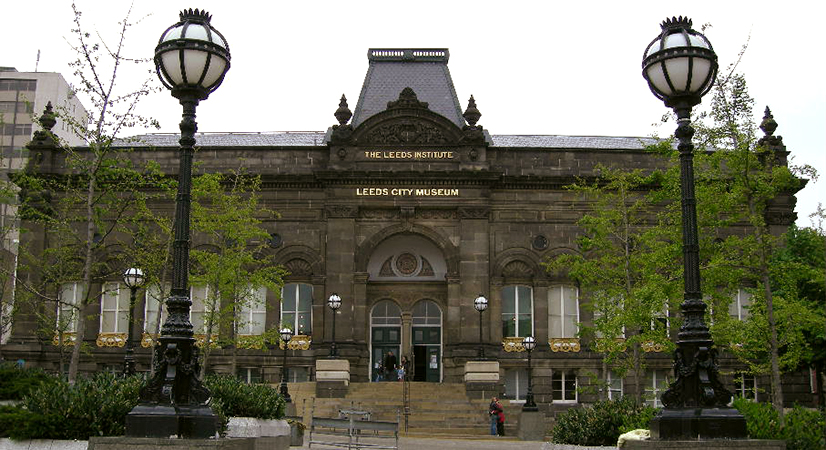

Above: Leeds City Museum. Photo: Art UK
Located in the heart of the Leeds city centre’s Millennium Square, the Leeds City Museum is a welcoming and innovative institution. One of nine sites across Leeds, the city museum is a capacious and striking building originally built in 1819. It is an interactive museum with carefully curated exhibition spaces that are perfect for engaging guests of all ages.
The Life on Earth exhibition is on the lower ground floor, just off the entrance. With over 800,000 species in the collection, including the famous taxidermy tiger and meteorites, the exhibition space is a boundless exploration of natural history. The skeleton of a long-finned pilot whale is suspended from the ceiling, immediately capturing the interest of the visitors.

The Ancient Worlds Exhibition Gallery is a personal favourite. Located on the third floor of the museum, it holds various objects from the Ancient Egyptians, Romans, and the Greeks. From art to architecture, the archaeology of the world is, quite literally, at your fingertips. Tucked into the corner is the 20th Dynasty mummy Nesyamun. Despite being over three thousand years old, you can still view an arresting reconstruction of his face. During the Blitzkrieg in 1941, two other mummies held by Leeds were unfortunately destroyed. Luckily, Nesyamun survived (figuratively) to continue to amaze sightseers from across the country. From Roman coin hoards to Cypriot figurines, each case is a stunning display of local and international history.

The third permanent gallery space is the World Cultures gallery, which hosts the vibrant, long-term exhibition Voices of India. The space celebrates the culture and the lives of the Asian diaspora in Leeds, as well as nationally and internationally. The museum strives to reflect the multicultural nature of the city and showcases its diversity across time. The City Museum also has significant collections of African, Oceanian, and North American objects.

One of the gallery spaces houses a shifting programme of exhibitions. Previous exhibitions have included Beavers to Weavers, an award-winning exploration of animals and how they interact with the rich ecosystems they inhabit. Due to COVID-19, one of its latest exhibitions, Fast X Slow Fashion, was transformed into an online exhibition instead and the website is well worth the visit. Exploring how clothing and consumerism has changed across Leeds since 1720, it is a nuanced, detailed exploration of fashion through the ages. One of the upcoming exhibitions, postponed by the pandemic, is Money Talks, an investigation into money and its uses across time. Now opening in February 2022, it includes objects relating to decimalisation and how currency influences everyone.

It is also worth noting that there are also flexible exhibition spaces for communities to curate their own exhibitions and showcase their heritage and histories. My personal favourite was the showcase of a photograph collection of the Windrush generation and their stories of their lives in Leeds. One of the more recent exhibitions at the Abbey House Museum focuses on light as a unifying experience, created by the members of the Inter Faith Week organisation.
As someone fortunate enough to have had a placement with Leeds Museums and Galleries, I know just how passionate each member of staff is about providing the best experience for their visitors. For me, there is no greater museum. Each cabinet and case reflect not just the brilliance of the objects and the history of Leeds but the dedication of the Leeds team.
Opening hours: Currently closed
Admission: Free
* * *

Steph Bennett is an Archive Assistant at the West Yorkshire Archive Service and a postgraduate student studying an MA in the History of Health, Medicine & Society at the University of Leeds. She has had a two-year internship with the University of Leeds Special Collections and a nine-month placement with Leeds Museums and Galleries. She was also the Curatorial Intern for the exhibition HERBARIUM at Leeds Central Library, based on the work of botanist Ida Roper. She did her year-in-industry with the Cultural Institute at the University of Leeds. She has future ambitions of continuing her career in heritage, hopefully through a curatorial role in either archives or museums.